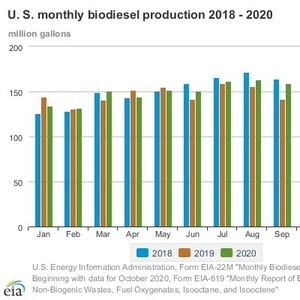EIA: Biodiesel production at 1.817 billion gallons in 2020

March 3, 2021
BY Erin Krueger
U.S. biodiesel production reached 159 million gallons in December 2020, up from 151 million gallons the previous month and up from 133 million gallons in December 2019, according to data released by the U.S. Energy Information Administration on Feb. 26. Production came from 85 biodiesel plants with a combined capacity of 2.5 billion gallons per year.
Production for the full year was at 1.817 billion gallons, up from 1.725 billion gallons in 2019, but down from 1.857 billion gallons in 2018.
Advertisement
Advertisement
Biodiesel producers sold 74 million gallons of B100 in December, up from 73 million gallons the previous month, and 73 million gallons of biodiesel sold as biodiesel blends, up from 72 million gallons in November. Ending stocks of B100 were at 49 million gallons in December, down from 52 million gallons in November, but flat when compared to the 49 million gallons of stocks reported for December 2019.
Sales of B100 for the full year reached 820 million gallons, up from 729 million gallons in 2019 and 765 million gallons in 2018. An additional 985 million gallons of biodiesel was sold in blends with petroleum diesel, down from 987 million gallons in 2019 and 1.093 billion gallons in 2018.
Advertisement
Advertisement
A total of 1.176 billion pounds of feedstock was used to produce biodiesel in December. Soybean oil remained the largest feedstock at 744 million pounds, followed by 147 million pounds of corn oil, 86 million pounds of yellow grease, 57 million pounds of white grease, 38 million pounds of tallow, 7 pounds of poultry fat, and 4 million pounds of other animal fats.
Additional data is available on the EIA website.
Related Stories
CoBank’s latest quarterly research report, released July 10, highlights current uncertainty around the implementation of three biofuel policies, RFS RVOs, small refinery exemptions (SREs) and the 45Z clean fuels production tax credit.
The USDA significantly increased its estimate for 2025-’26 soybean oil use in biofuel production in its latest World Agricultural Supply and Demand Estimates report, released July 11. The outlook for soybean production was revised down.
The U.S. Energy Information Administration maintained its forecast for 2025 and 2026 biodiesel, renewable diesel and sustainable aviation fuel (SAF) production in its latest Short-Term Energy Outlook, released July 8.
XCF Global Inc. on July 10 shared its strategic plan to invest close to $1 billion in developing a network of SAF production facilities, expanding its U.S. footprint, and advancing its international growth strategy.
U.S. fuel ethanol capacity fell slightly in April, while biodiesel and renewable diesel capacity held steady, according to data released by the U.S. EIA on June 30. Feedstock consumption was down when compared to the previous month.
Upcoming Events










